The Guardians have awoken, giant and ferocious, and it is up to the Foxen Kingdom of Skulk Hollow to vanquish the beasts.
In Reaping the Rewards, I take a look at the finished product from a crowdfunding campaign. Skulk Hollow was originally funded on Kickstarter in the fall of 2018, and was delivered to backers in the fall of 2019. This review is modified from my original Kickstarter Tabletop Alert to show the finished components.
What Is Skulk Hollow?
Skulk Hollow is an asymmetric battle game for 2 players, ages 8 and up, and takes about 30 minutes to play. It retails for $49.99 and is available in stores or directly from the publisher. The game involves battling in a fantasy setting; the rules aren’t too difficult to grasp for kids, and the difficulty of the game will just be driven by the skill level of the two players.
Skulk Hollow was designed by Keith Matejka and published by Pencil First Games, with illustrations by Dustin Foust and meeple design by Helen Zhu.

Skulk Hollow Components
Here’s what’s included:
- Game Board
- 25 Power cubes
- 25 Heart tokens
- 6 Ancient Relic tokens
- Foxen:
- Foxen deck
- 4 Foxen Noble cards
- Foxen player mat
- 10 Foxen meeples
- Grak:
- Grak board
- Grak player mat
- Grak deck
- Dead Foxen meeple
- Grak meeple
- Raptra:
- Raptra board
- Raptra player mat
- Raptra deck
- Raptra Air/Land card
- Cloud token
- Raptra meeple
- Tanthos:
- Tanthos board
- Tanthos player mat
- Tanthos deck
- 6 Tentacle meeples
- Tanthos meeple
- Apoda:
- Apoda board
- Apoda player mat
- Apoda deck
- 4 Rune tokens
- Apoda meeple

The prototype for Skulk Hollow was pretty much complete, down to the custom plastic tray insert, so the finished game looks quite similar, though with one additional Guardian included: Apoda. The Foxen team and the Guardians each have their own tuckbox to contain their specific cards and meeples. Also, there are lots of character-specific reference cards so that you can pass your opponent your card so they know what actions you can take.
The Foxen components and the main map are used in every game, combined with one of the Guardians. Most of the Guardian components are similar (a board, a deck of cards, a player mat), but each one has a couple things unique to it. I’ll cut to the chase: the components for this game look fantastic.
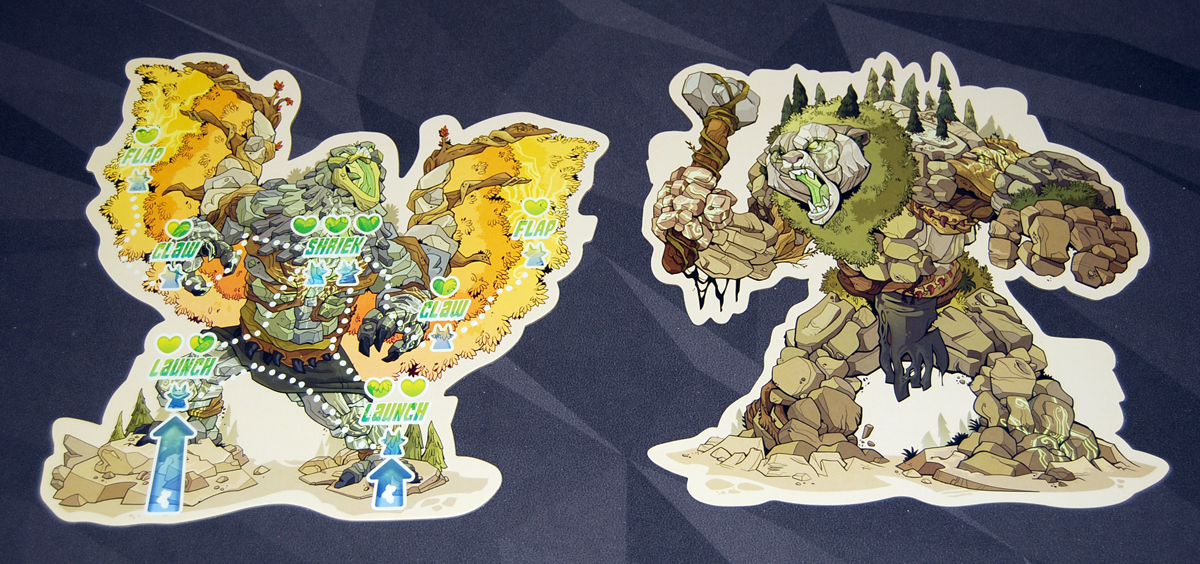
The illustrations for the game are by Dustin Foust: you can see more of that here. The Foxen characters look like something you might expect to see in a graphic novel or a new animated series on Netflix—a lot of personality, but not cutesy, either. The Guardians are amazing: giant creatures (hawk, octopus, bear) made up of rocks and plants. The backs of the Guardian boards feature the illustrations without the game icons, and they’d look great framed on the wall.
The game board, also illustrated by Dustin Foust, shows the Foxen keep on one corner and the Guardian’s lair on the other, and lots of details in between. It’s lovely to look at, and adds a lot of visual impact to what is really just a large 3×3 grid.
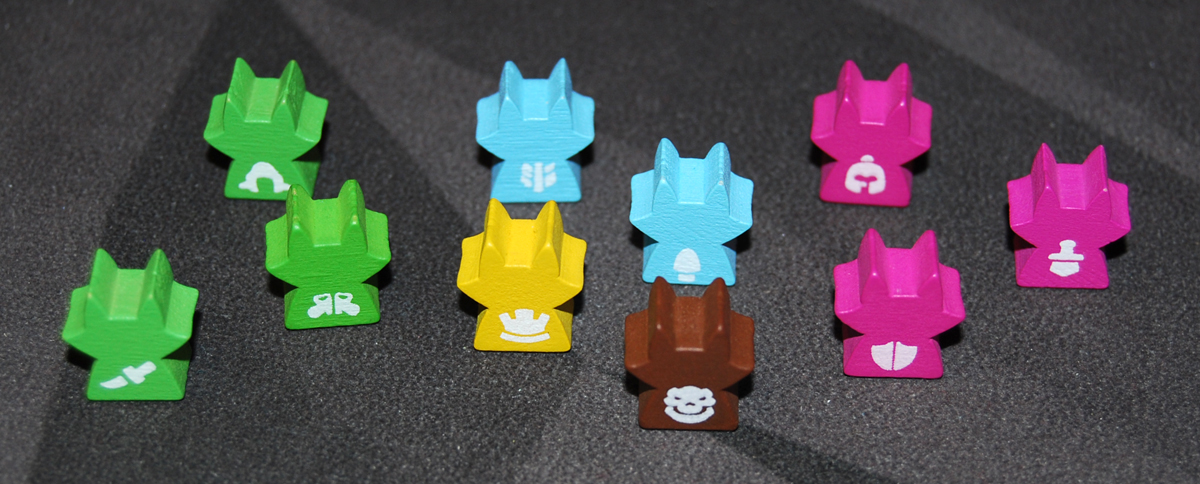
The meeples were designed by Helen Zhu of Happy Valley Meeple Farm, which also designed meeples for Pencil First’s Legendary Creatures and Sunset Over Water, and they’re wonderful. The Foxen meeples are small foxes, colored to indicate the various types of Foxen units, and also marked with small icons to distinguish them (so you can tell which knight is which, for instance). The Guardian meeples are large and impressive; Tanthos also comes with six tentacle meeples with unique shapes.

The cards and player boards are fairly easy to interpret for the most part. The icons in the card corners are silhouetted versions of the illustration of the action depicted on the card itself, but the player boards and reference cards show a tiny copy of the illustration, not the icon, so they don’t match exactly. That’s a fairly minor issue, though, and I think the only complaint I had with the components—it can make the cards a little hard to read when they’re overlapping in your hand, but if you splay them out further then the actions are obvious.
How to Play Skulk Hollow
You can download a copy of the rulebook here and it is also available to play on Tabletop Simulator for free.
The Goal
The Foxen Heroes want to eliminate the Guardian; the Guardian wants to eliminate the noble of the Foxen Heroes, or else achieve its alternate goal, which varies depending on the Guardian.

Setup
Place the map in the center of the table, oriented diagonally so that the keep is facing the Foxen player and the lair is facing the Guardian player. Place the hearts and power cubes nearby.
The Guardian player chooses a Guardian, taking all the components and setting the Guardian board next to the map. The Guardian meeple is placed in the lair on the map. Some of the Guardians have additional setup instructions.

The Foxen player takes their components and chooses one of the nobles, setting its card next to their player mat. (The unused nobles are returned to the box.) Find the sentinel card and place it next to the noble. The noble and the sentinel meeples are placed on the keep on the map. The rest of the meeples are set nearby as a supply.
Both players shuffle their own decks and draw cards equal to their hand size, as shown on the player mats. The Foxen player goes first.
Gameplay
On your turn, you take actions, and then do a cleanup phase.
Each player has a number of actions shown on their player board (e.g. the Foxen Heroes get 3 actions). You may spend actions to play cards or prepare—discard one card to draw 2 from the deck. If you have power cubes on your Foxen characters or Guardian playmat, you may discard power cubes to take additional actions that don’t count toward your action limit.
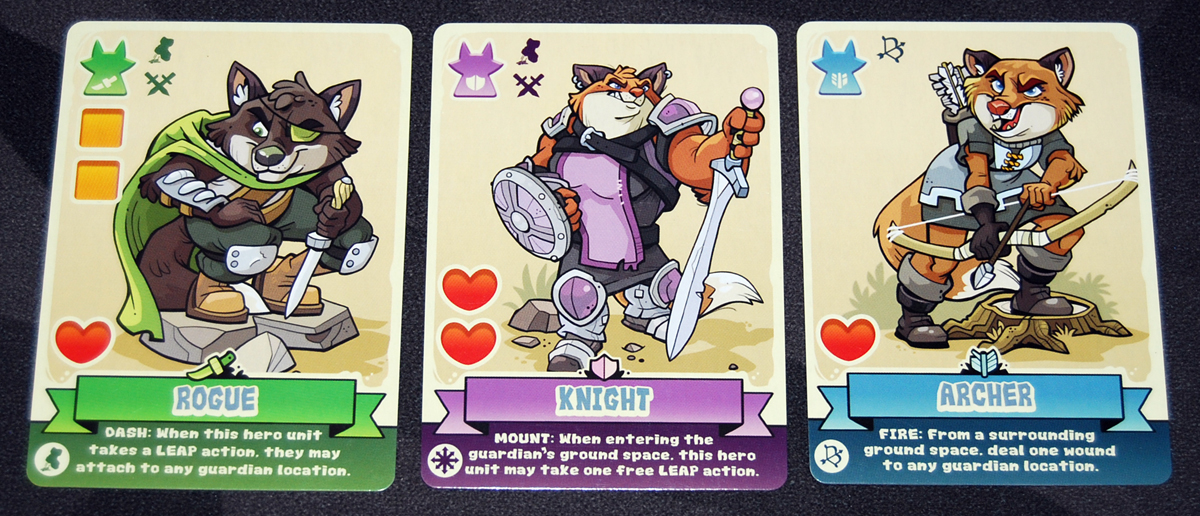
The Foxen deck includes units that may be recruited. Play the card face-up on the table, and then place the corresponding meeple on the keep or one of the two space adjacent to it (the towns).
The rest of the Foxen deck consists of order cards, used to let your various units take actions. Each card has two actions pictured—when you play an order, you get to choose one of the actions. You will use actions to move around on the map, gain power cubes, leap onto the Guardian, and strike with melee or missile attacks.

When you leap, you may either jump from the ground onto the Guardian board (if you’re in the same space), or else move from one space on the Guardian board along the path to another spot. Each location has icons showing how many units may be present there, and how much health that location has before it is disabled. Melee attacks strike the Guardian at a location where your unit is present. Missile attacks depend on which unit you’re using: for instance, the archer can strike from any space on the map surrounding the Guardian, but the sentinel can only use a missile attack if it’s on the same space as the Guardian. Not every unit has access to every type of action—these are indicated on the unit cards.

Meanwhile, the Guardian’s action cards also include movement on the map board and various types of attacks and actions. Most cards include two actions to choose from, and the list of actions varies based on the Guardian. For instance, Tanthos can spawn tentacles, use them to pull Foxen units, and crush units. Each Guardian has “mend” actions to heal wounds on the Guardian board, as well as ways to attack units on the ground, and either attack or remove units on the Guardian board.
In order to use an action, the associated location on the Guardian board must be active. For instance, Grak’s “Gaze” ability is tied to its eye, which has four hearts. If all of the hearts are filled on the Guardian board, Grak cannot take the “Gaze” action unless it mends the eye to reactivate it.
One note is that the noble cannot be affected by Guardian actions unless it is alone—if it is on the same map space or the same location on the Guardian board as another Foxen unit, any Guardian actions targeting that location only affect the other Foxen units.
At the end of your turn, you may allocate any power cubes that you acquired this turn onto available spaces on your units or Guardian board (discarding any excess), and then you draw cards. If you have fewer than your hand size, you refill your hand. If your hand is already full (or more than full), you draw one card.
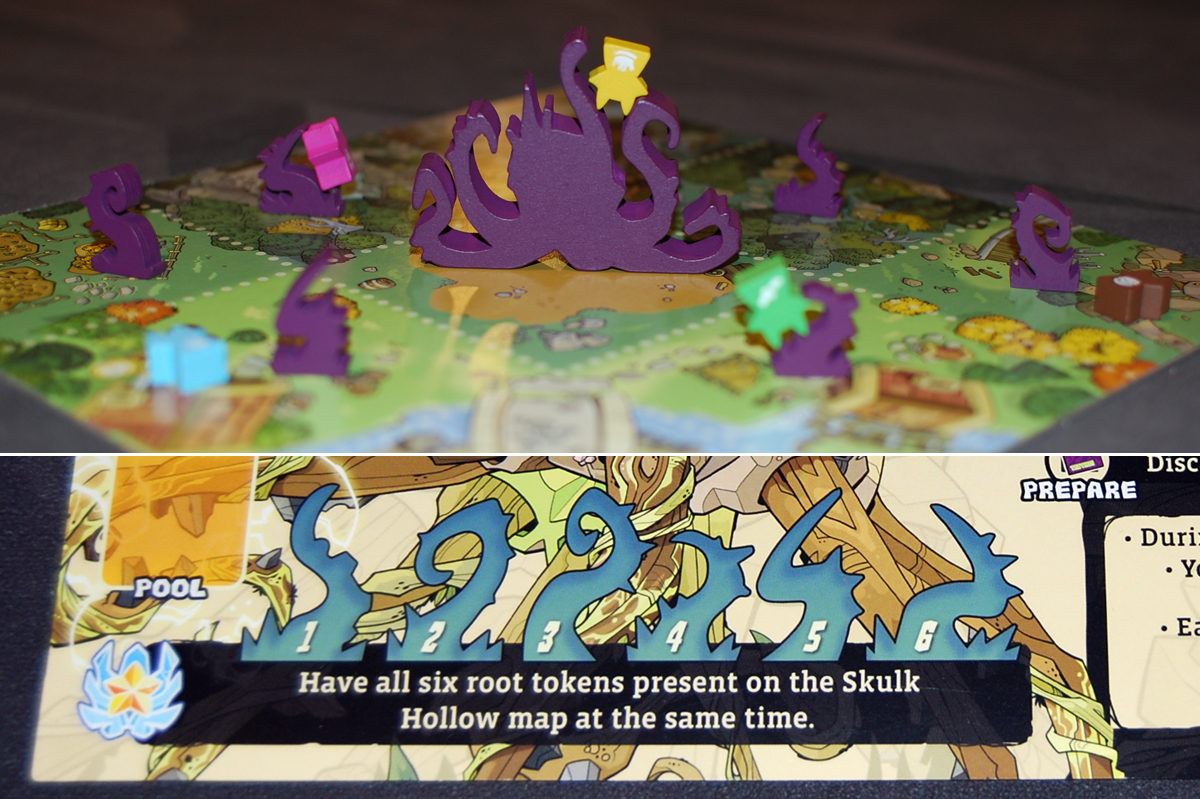
Game End
The game ends immediately when either player hits their victory condition. The Foxen player wins if all of the locations on the Guardian board are disabled. The Guardian player wins if it eliminates the Foxen noble, or achieves its other goal:
- Grak: eliminate 8 Foxen units.
- Raptra: eliminate all units besides the noble on the ground.
- Tanthos: spawn all 6 tentacle tokens onto the map.
Why You Should Play Skulk Hollow
Skulk Hollow has a great David-vs-Goliath feel to it, although you can’t be sure that David is going to bring down the giant in this scenario. I love the way that the Foxen Heroes and the Guardians feel so different from each other: on one side, tiny foxes spread out on the map or swarm on the Guardian itself, hoping to inflict a few wounds before they’re flung off; on the other side, the massive Guardian stomps and crushes … if it can be quick enough. I’ve been curious about this one ever since Ed Baraf showed me an early peek at some of the artwork last year at Gen Con, and I’m excited it’s finally here on Kickstarter.
I was able to get a prototype for a couple weeks during the Kickstarter campaign, and I tried it out first with my 12-year-old daughter. We ended up playing three games in a row the first time, because she wanted to try out all of the Guardians. And then we played more, taking turns being Guardians and foxes, trying out different tactics as she tried to outmaneuver me. (I still have an edge on her most of the time, but she did manage to wipe me out with Raptra.) I also played against some adult friends as well, and it often resulted in multiple plays in a session because it’s fun to try out the different roles.
Honestly, I don’t generally play a lot of two-player only games, because if I host a game night I’m generally going to have more than one person show up, plus my daughter usually joins in for at least a couple games. But with Skulk Hollow on my shelf, I found myself looking forward to low attendance on game night so I could get it to the table.
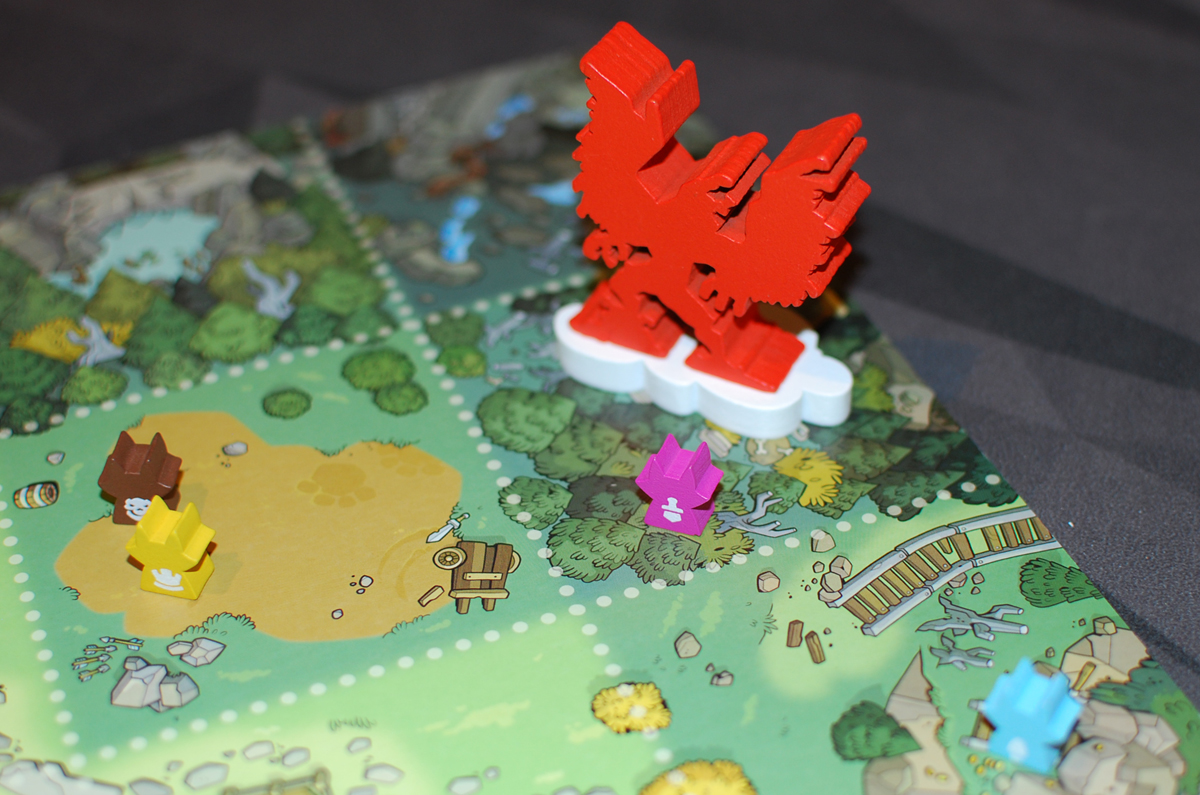
I really liked the way the Guardians feel different because of the actions available to them—which changes the game even for the Foxen player, who will need to adapt their strategies to the current threat. Raptra has the ability to fly into the air, with some actions that only apply while it’s on the ground, and some while it’s in the air. While in the air, the Foxen heroes cannot leap up onto the Raptra board—but Raptra also wins if there are no units (besides the noble) on the ground, so you can’t commit all your units onto the Raptra board, either.
Each of the Guardians has different ways to deal with the little varmints crawling all over them. Grak simply throws them back onto the map, and can fling them all the way across the board. Raptra can flap its wings to knock units off, or to push them around on the map. Tanthos has a shocking personality, zapping units on itself or in its own space, but can’t actually remove any units except by killing them off.

Tanthos sprouts up root tentacles and can use them to pull Foxen units around and then crush them—and the more tentacles are present, the more damage they do. The Foxen player will need to spread out to prevent roots from spreading, but you can’t spend too much time just attacking the roots because that doesn’t get you closer to killing off Tanthos.
Each player only gets a limited number of actions per turn, so you have to choose wisely. Power cubes can give you extra actions to use later, but they take actions to acquire now. And if you spend some actions gaining power cubes for your Foxen rogue, and then that rogue gets killed off in the next turn … well, maybe you should have gotten your rogue to a safer spot first. Using the “prepare” action to draw more cards and cycle through your deck can also be really important, even though it feels like you’re not doing enough. As a Guardian, you only have so many cards that let you heal, so you may need to spend actions just to draw, particularly if you need to heal a location so that you can take a particular action. Or, if you’ve got units crawling on your back, you’ll want to dig for the actions that can get rid of them.
Skulk Hollow provides a nice, tense tactical battle, and I really love the asymmetry of the band of tiny foxes against the lone behemoth. There is some luck involved in what cards you draw, but the better you get to know the decks, the more you’re able to plan out your moves, using “prepare” and gaining power to set up your hand for a killer turn later. Designer Keith Matejka is probably best known for Roll Player, a wacky game about character creation, but Skulk Hollow reminds me more of his earlier game Bullfrogs, which is more of a tactical battle game. Skulk Hollow is a little less chaotic than Bullfrogs because there are only two players, so it gives you a little more ability to read your opponent and try to predict their next moves.
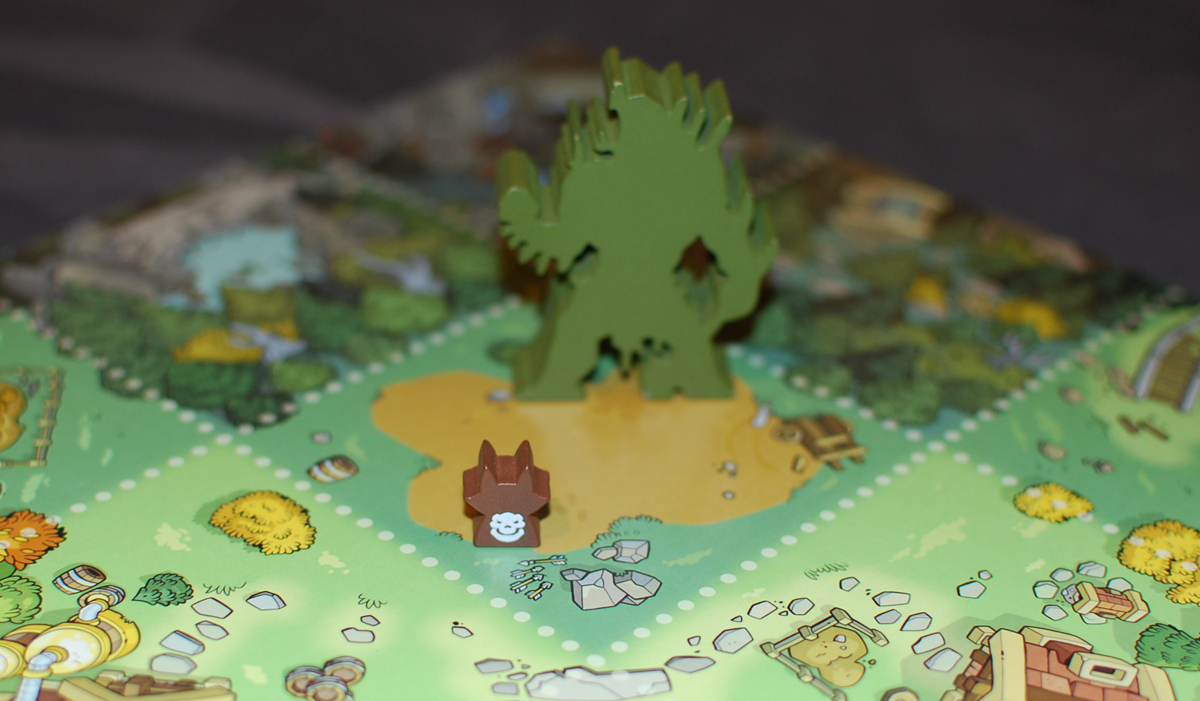
If you like battle games, particularly with some asymmetry and special powers, Skulk Hollow is one that you won’t want to miss! Next week, Pencil First Games will be launching a Kickstarter campaign for the sequel, Maul Peak, introducing another set of heroes and Guardians, so stay tuned.
For more information or to make a pledge, visit the Skulk Hollow website!
Click here to see all our tabletop game reviews.
![]() To subscribe to GeekDad’s tabletop gaming coverage, please copy this link and add it to your RSS reader.
To subscribe to GeekDad’s tabletop gaming coverage, please copy this link and add it to your RSS reader.
Disclosure: GeekDad received a copy of this game for review purposes.






